
by Ray Bodrey | Oct 14, 2021
Tree dieback is a complex syndrome and slow developing. Dieback is essentially a process in which trees lose leaves and limbs. This usually occurs as a result of severe stress to the tree’s bark or root system, but could be a result of a declining life cycle.
It’s important to note that there is a significant balance between a tree’s root system and the number of leaves and limbs it can support. For example, if a tree loses part of its root system, possibly due to disease or lawn equipment damage, the tree will forfeit a portion of its leaves. Dieback doesn’t happen overnight, though. It’s a slow process, with larger trees taking much longer time for signs of stress to emerge. However, a large tree root system is very sensitive to damage, whereas a small tree will adapt quickly and is much more resilient to damage. So, what can be done to prevent dieback in trees?
First and foremost, trees, like all living things, have a natural life cycle. Regardless of how you care for your trees, dieback will occur. The most important management measure in extending the life of a tree is to protect the root system and bark.
With each passing year, a tree grows new bark in the rejuvenation process. The bark replacement process inevitably becomes more difficult as the tree gets older and in turn the tree is more and more susceptible to dieback. If the bark becomes damaged, especially later in the tree’s life cycle, then fungi and insects have a much greater chance to cause serious harm. Treating bark damage with a wound dressing to prevent decay is the recommended procedure.
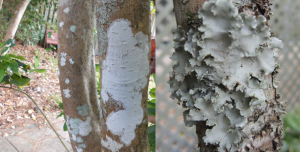
Lichens come in many forms and are commonly blamed for the decline and death of trees and shrubs, however they do not cause harm. Credit. Sydney Park Brown and Joseph Sewards, UF/IFAS.
A common misconception is that epiphytes, such as lichens and Spanish moss, are tree diseases. Epiphytes are known as “air plants” and thrive in the Panhandle. They survive on moisture and nutrients in the atmosphere and are harmless to trees. However, a tree that becomes inundated with epiphytes may be an indicator of excessive soil moisture, which may lead to root rot.
Lawn weed killers can have detrimental effects to trees, even if the application seems to be from a safe distance. When using a weed killer near a tree’s root system, confirm on the label that the product is designed to kill green growth only. It can’t be overstated that excessively fertilizing an old tree will greatly accelerate the decline of the tree. Some may think this will stimulate a tree and extend its life, but instead it will do the opposite. Young trees can tolerate fertilizer applications, as they need crown growth. Older trees will simply become top heavy, and structural damage will likely occur.
Don’t forget, trees need space too. A mature tree forced to occupy a small space will simply not adapt. Be sure to have adequate spacing when planting younger trees and shrubs in the vicinity of older trees. Also, keep your trees pruned away from touching structures and utilities.
Tree dieback is a complex issue to manage. By following these measures, you can help extend the life of your trees and continue to have a picturesque landscape.
For more information on tree dieback, contact your local county extension office.
Please visit Florida Friendly Landscaping, http://fyn.ifas.ufl.edu/, for more information on maintaining your landscape.
For more general information on lichens, please see UF/IFAS EDIS document “Spanish Moss, Ball Moss and Lichens-Harmless Epiphytes” by Joe Sewards and Dr. Sydney Park Brown: https://edis.ifas.ufl.edu/pdffiles/EP/EP48500.pdf
UF/IFAS Extension is an Equal Opportunity Institution.
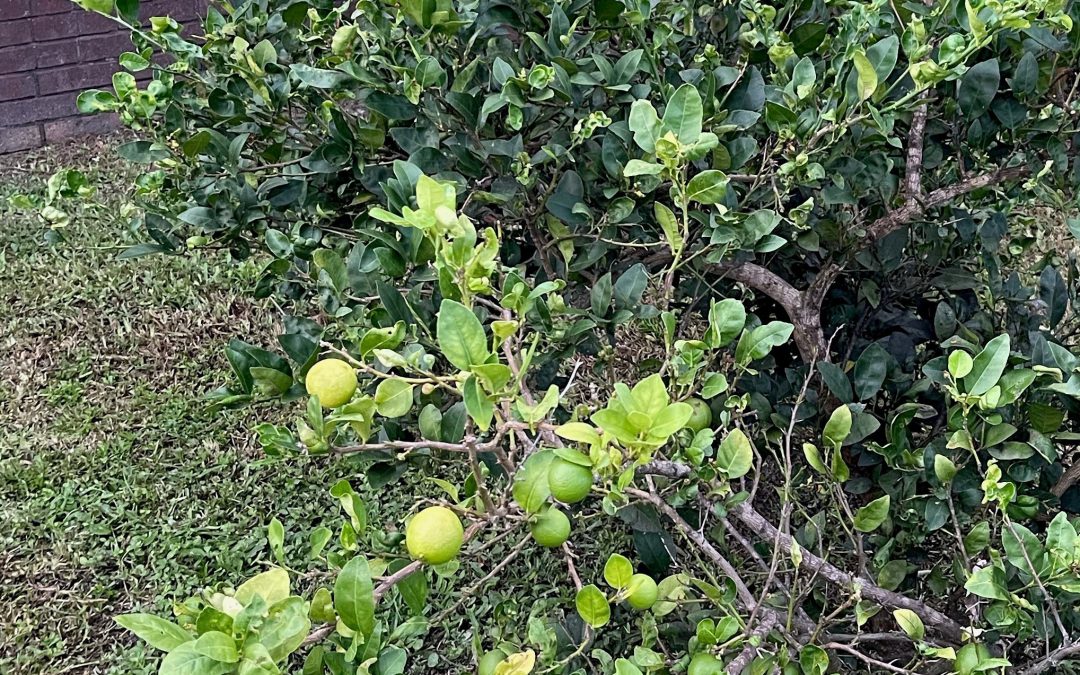
by Ray Bodrey | Sep 9, 2021
Growing Key Limes in the home landscape is not only a fun and unique addition, but is also delicious – any way you slice them.
The key lime, Citrus aurantifolia, originated in southeast Asia. Genetically speaking, the key lime is likely a tri-hybrid cross between the “odd ball fruits”, known as citron, pummelo and a microcitrus species, Citrus micrantha. There is little commercial key lime production nowadays in Florida, but the fruit remains a very popular landscape option.
The key lime is a small, bushy tree that makes harvest and pruning a breeze. Like most citrus, it’s self-pollinating. The key lime is also an ever-bearing fruit, so there is no real seasonal harvest. The tree could technically bloom any month of the year. There are very few varieties, as trees mostly come from true seed or air layering.
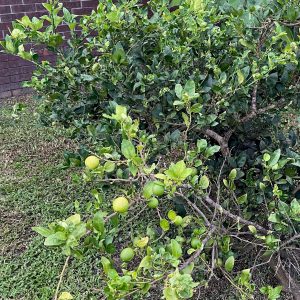
Key Lime fruit at various degrees of ripeness. Photo courtesy of Ray Bodrey, UF/IFAS Extension Gulf County.
Climate is an important factor when deciding to plant a key lime. They are sensitive to cold temperatures, especially below freezing. For the Panhandle, it’s wise to keep key lime trees as patio citrus. In other words, keep the trees in pots so that they can be moved indoors for protection during the winter months. In the ground, trees should be planted in an area where there is a significant wind block. Once a few years have passed and tree has become more mature and acclimated to the environment, they may be able to survive on their own, though it is recommended to cover the tree under sub-freezing temperatures. However, it is important to remember that sunlight is a catalyst for citrus fruit production, be sure to plant the tree in an area with full sun.
The usual suspects of citrus insect pests apply to the key lime also. Citrus leaf miner and mites are the most common culprits. Horticultural and insecticidal oils will certainly help to combat these threats. For planting, key lime is well adapted to a variety of soil conditions in Florida. Be sure to water newly planted trees every other day for the first week and then one to two times a week for the first couple of months. Water periodically after that, making sure the soil doesn’t stay completely dry for long periods. A 6-6-6 fertilizer works great for the key lime. Please follow the fertilizer schedule found in the UF/IFAS EDIS publication, “Citrus Culture in the Home Landscape” by Robert E. Rouse and Mongi Zekri: https://edis.ifas.ufl.edu/pdf/HS/HS132/HS132-11822781.pdf
A final interesting thing about the key lime is the ripening stages of the fruit. Because key limes are ever-bearers, blooms can develop at sometimes widely varying times. This causes an uneven development of fruit across the tree. Be sure to wait until the fruit turns begins to turn yellow before harvest. That’s when it’s mature to eat! Fruit can be stored for up to a week in the fridge or can be juiced and stored in the freezer for later use.
Please contact your local county Extension office for more information. Happy Gardening!
Information for this article can be found in the UF/IFAS EDIS publication, “Key Lime Growing in the Florida Home Landscape” by Jonathan H. Crane: https://edis.ifas.ufl.edu/publication/CH092
UF/IFAS Extension is an Equal Opportunity Institution.
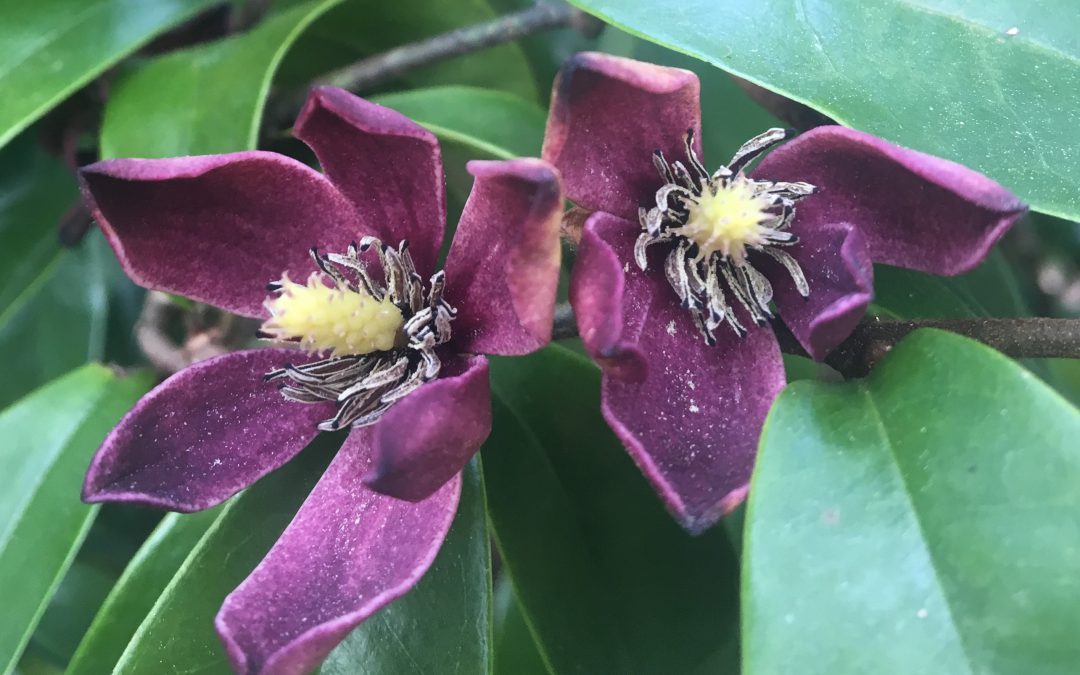
by Gary Knox | Sep 2, 2021
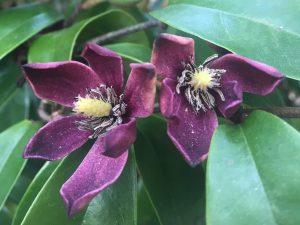
‘Stellar Ruby’ is a new purple-flowered hybrid banana-shrub that will soon be released nationally
You just learned about a fabulous new plant, and you HAVE to have it. How can you acquire this rare treasure?
Many of us gardeners have experienced this desire for a “new” plant but have quickly become frustrated with trying to locate and buy that particular plant. It’s not easy, or else that plant wouldn’t be new or rare, but the four P’s outline a few strategies for satisfying a “new” plant passion: plant societies, plant institutions, patience and payment.
Plant societies are one of the best avenues for acquiring new plants. Most plant societies consist of members with intense interest in particular plants or plant groups, so find the society that supports the plant that interests you. Plant society members often include breeders or plant explorers who introduce new plants. Whether magnolia or camellia or conifers or other plants, membership in such societies can give you a leg up on learning about, seeing, and accessing new plants. Consequently, fellow society members are often the first to acquire the newest plants, and that could be you!
Beyond this, participation in generalist plant groups can also give you unexpected benefits of networking with like-minded people. Thus, don’t overlook groups like Master Gardeners, garden clubs, or garden/park support groups. Their members often include passionate plant people like you who may have more connections (or special plants) than you realize.
Similarly, plant institutions such as universities or botanic gardens are another way to learn about and acquire new plants. These institutions often hold plant sales or fund-raising plant auctions that include new, unusual or rare plants. Online plant sales or auctions are becoming more common, so distance is less of an obstacle than it used to be. However, these institutions are less focused on particular plants, so it may be hit-or-miss to find that particular plant you want. To increase the chances of finding your desired plant, contact these institutions and ask to be notified about these events. You may even find a plant you didn’t know you wanted!
Patience is a virtue when trying to acquire new plants. Some plants take a long time to propagate or are not easy to propagate or grow. If you have the patience to wait, many plants will become more available – – – and at a more reasonable cost – – – as nursery production catches up to demand.
Finally, “payment”: let’s face it, money talks! If you have the funds, you can usually find the means to acquire the plants you desire. Most new or rare plants usually enter the market through specialty nurseries, operations that often maintain their own breeding or plant exploration programs or have exclusive arrangements with those who do. This is an expensive means of obtaining new plants, and therefore these specialty nurseries rightly charge more for their plants.
Another way money works to your advantage is the ability to travel. Many specialty nurseries, collectors, etc. often aren’t found in our part of Florida. If you can travel to these nurseries, botanic gardens, etc., it will be much easier to acquire unusual plants. If you can’t afford special trips to these sites, consider taking vacations to areas near these specialty nurseries, or to areas where these specialty nurseries are “on the way” to your vacation destination.
It goes without saying that you should learn about a “new” plant as much as possible before investing in an extensive hunt. Simple internet searches should tell you if that plant will be adapted to the climate and soil of your garden. At the other extreme, check resources like the IFAS Assessment (https://assessment.ifas.ufl.edu/) to make sure that particular plant won’t become invasive in your region of Florida.
Gardening is a very fulfilling activity, and the excitement of “new” plants just makes gardening more fun! Happy hunting!
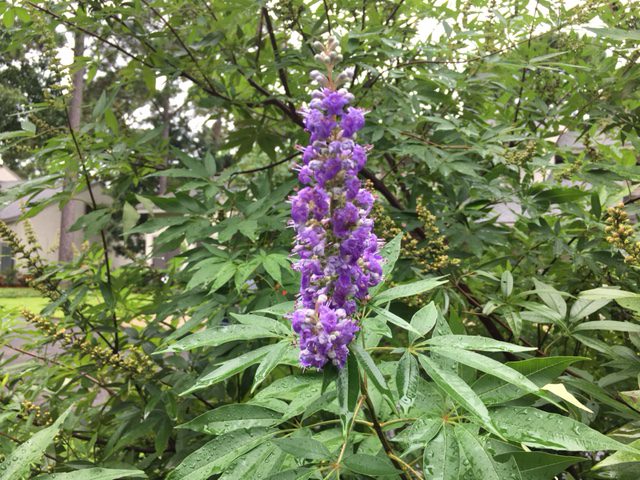
by Sheila Dunning | Aug 26, 2021
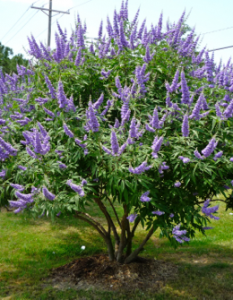
Photos by Sheila Dunning
The showy chaste tree makes an attractive specimen as the centerpiece of your landscape bed or in a large container on the deck. Much more of them are being seen since the Florida Department of Transportation has recognized the tree as a desirable median planting. Easy-to-grow, drought resistant, and attractive to butterflies and bees, Vitex agnus-castus is a multi-stemmed small tree with fragrant, upwardly-pointing lavender blooms and gray-green foliage. The chaste tree’s palmately divided leaves resemble those of the marijuana (Cannabis sativa) plant; its flowers can be mistaken for butterfly bush (Buddleia sp.); and the dry, darkened drupes can be used for seasoning, similar to black pepper, making it a conversation piece for those unfamiliar with the tree.
Vitex , with its sage-scented leaves that were once believed to have a sedative effect, has the common name “Chastetree” since Athenian women used the leaves in their beds to keep themselves chaste during the feasts of Ceres, a Roman festival held on April 12. In modern times, the tree is more often planted where beekeepers visit in order to promote excellent honey production or simply included in the landscape for the enjoyment of its showy, summer display of violet panicles.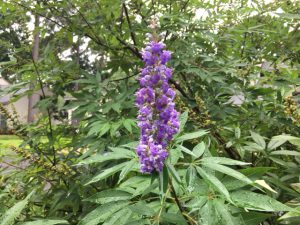
Chaste tree is native to woodlands and dry areas of southern Europe and western Asia. It will thrive in almost any soil that has good drainage, prefers full sun or light shade, and can even tolerate moderate salt air. Vitex is a sprawling plant that grows 10-20 feet high and wide, that looks best unpruned. If pruning is desired to control the size, it should be done in the winter, since it is a deciduous tree and the blooms form on new wood. The chaste tree can take care of itself, but can be pushed to faster growth with light applications of fertilizer in spring and early summer and by mulching around the plant. There are no pests of major concern associated with this species, but, root rot can cause decline in soils that are kept too moist.
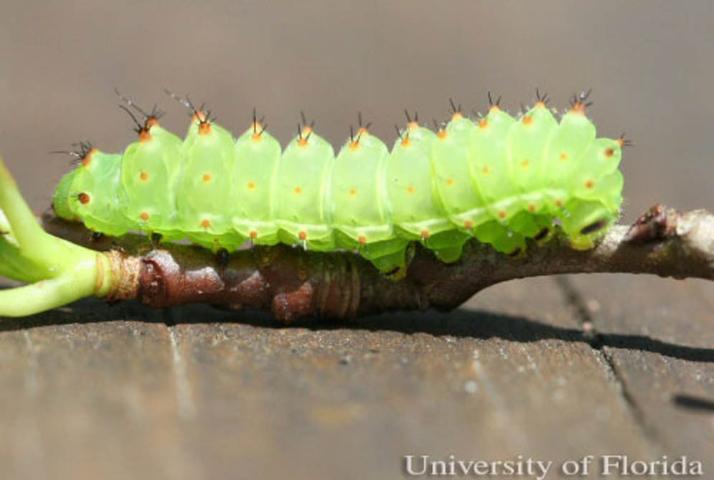
by Carrie Stevenson | Aug 5, 2021
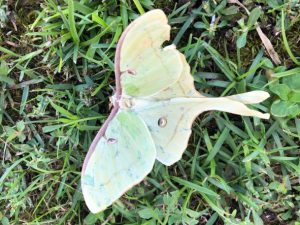
The moon-like eyespots and long tails on its wings are identifying features of the luna moth. Photo credit: Carrie Stevenson, UF IFAS Extension
We hear about butterflies all the time–their beautiful wing patterns, how to plant entire gardens for them, and the fascinating migration patterns of monarchs. But if you look around, you might just find their night-dwelling cousins, the moths, have some pretty incredible traits, too.
I find luna moths (Actias luna) just as interesting as many of the colorful butterflies native to our area. Luna moths are considerably larger than the little brown and black moths you see fluttering around streetlights. Their wingspan can be up to 4” wide, with long, tapering tails trailing behind them. The moth is native to the entire eastern portion of the United States, but has a longer life span the further south it resides. Luna moths live year-round in Florida, with up to three generations (trivoltine) born annually. They are pale green, and adults have a furry white underbelly. Lunas are so eye-catching that they have been featured on the cover of a field guide to moths, postage stamps from the United States and other countries, and as the mascot of the insomnia medication, Lunesta.

The caterpillar of the luna moth is bright green and warns off predators by making an intimidating clicking sound. Photo credit: University of Florida
Luna moths have several celestial ties in their name. All the moths in its larger family, Saturnidae, have round eyespots (which fool would-be predators) composed of concentric circles like the rings of Saturn. “Luna” comes from the Latin for moon, after the moon-colored eyespots on its back.
Luna moth caterpillars are fat and green—the classic caterpillar—and about 2.5” long. Their preferred host plants in the south are typically sweet gum, hickory, walnut, and persimmon trees. Interestingly, the caterpillars can make a sound, typically described as a clicking noise. Biologists believe this noise-making is a defense mechanism, performed as a precursor to spitting up unpleasant fluids to fend off predators. Several studies have shown that the twisting motion of the adult luna moth’s long tails in flight can interrupt the echolocation of bats, helping the moths evade predation.












